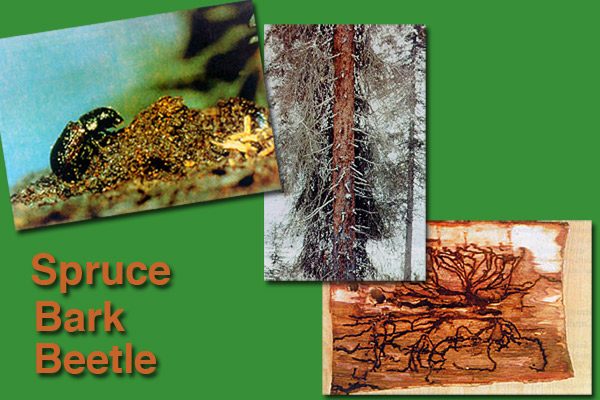
UPDATE Aug. 7, 2019
Today’s program was pre-recorded. We will not be able to take questions or emails. However, we have updated information on the spruce bark beetle outbreak below:
While this program was recorded a year ago, the spruce bark beetle outbreak continues. One of our guests from last year, Jason Moan, provided these fresh updates for 2019:
1. Based on surveys so far this year, the outbreak is still in process and is expanding into areas around the periphery of those already affected.
2. There are no predictions regarding the length of the current outbreak. Outbreaks are cyclical but duration varies depending on conditions. An outbreak requires a large scale disturbance, like a windstorm; plenty of susceptible trees; and favorable weather conditions. Warm weather is favorable for the beetles. An outbreak event will subside when weather conditions are unfavorable; when the availability of host trees is exhausted; and populations of natural enemies to the beetle increase.
3. An anti-aggregation pheromone tested last year was not successful in protecting white spruce in Alaska, although forestry professionals had some success with it in the Rocky Mountains. New tools to protect high value spruce in Alaska are being tested this year. One is a different formulation of an anti-aggregation pheromone, and the other is a systemic pesticide injected directly into the tree. Researchers may have some preliminary results in Fall 2019.
4. 2019 aerial surveys to assess forest health are still underway. Some surveys in the west were incomplete because work was inhibited by smoke. The surveys are a cooperative effort between the USDA Forest Service and the Alaska Division of Forestry. Both agencies will make the survey results available through their websites when complete; links are not yet available.
ORIGINAL STORY:
It’s hard to scan a forested hillside and see those dead spruce trees in among the green-leafed deciduous stands. The U.S. Forest Service and the Alaska Division of Forestry have good information on their websites about the spruce bark beetle. We’ll share those resources, and speak with foresters about this pest’s life cycle, how widespread the reach is in Southcentral Alaska, and what advice they offer for the homeowner on how to protect their own trees.
Here’s some of what we found out, from the Alaska Div. of Forestry:
- spruce bark beetles are less than a quarter inch long
- they infect Sitka, white and Lutz spruce, but rarely black spruce
- they live in the thin phloem, or growing area, between the bark and the wood
- a female can lay 10 to 150 eggs in galleries beneath the bark
- when temperatures are above 60-degrees in mid-May through mid-July, the beetles fly to new host trees
- they thrive on wind-thrown, fallen or injured trees
- since the mid-1970s, these beetles have affected about 50 percent of the Kenai Peninsula’s forested land
HOST: Kathleen McCoy
GUESTS:
- Stephen Burr, forest entomologist, U.S. Forest Service
- Jason Moan, Forest Health Program, AK Div.of Forestry
LINKS
- Spruce beetles in Alaska forests, US Forest Service, AK. Div. of Forestry, Cooperative Extension Service joint website
- Spruce Bark Beetle, U.S. Forest Service, Forest Insect & Disease Leaflet 127
- What’s bugging Alaska’s forests? Spruce Bark Beetle Facts & Figures, Alaska Division of Forestry website
- US Forest Service Forest & Grassland Health website
- Guide for home and woodlot owners, Southcentral & Interior Alaska, (4-pg PDF), UAF Cooperative Extension Service
- Spruce Beetles:What they are and what to do about them (4-min video) UAF Cooperative Extension Service
- FAQ on spruce bark beetle, www.alaskasprucebeetle.org
- Spruce beetles in Alaska forests, US Forest Service, AK. Div. of Forestry, Cooperative Extension Service joint website
- Spruce beetles take flight in search of new host trees, July 6, 2018, Alaska Public Media
- Pesticides, Management, Spruce Bark Beetle, www.alaskasprucebeetle.org
PARTICIPATE:
- Because this program was pre-recorded, we will not be taking phone calls or emails during the show.
- RE-AIRING: Monday, August 12, 2019 at 2:00 p.m.
- REPEAT: Monday, August 12, 2018 at 8:00 p.m.




